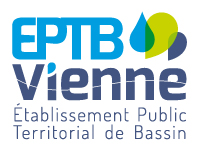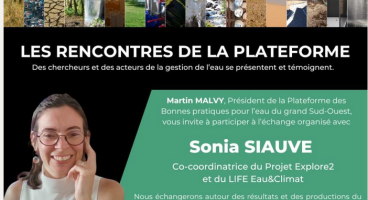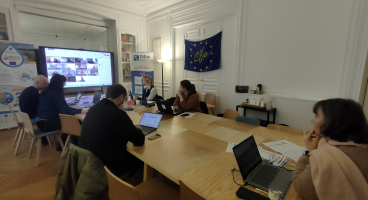ACTION C1 : DEVELOPMENT AND VALIDATION OF DECISION SUPPORT TOOLS FOR LOCAL STAKEHOLDERS
This action will result in the development of two tools: a tool for diagnosing local vulnerabilities and a tool to propose adaptation trajectories to climate change.
The lead partner for this action is ACTIERRA.
C1.1 - Tools and methodology for diagnosing local vulnerabilities
This diagnostic tool will be based on a implementation, at the SAGE level, of the method for developing maps of vulnerability to climate change in catchment areas by 2030 and 2050, implemented in most of the adaptation plans of the water agencies, with an application that automates the computations and displays the results on a local scale (10 km2 grid). This method combines climatic, hydrological and environmental indicators in order to calculate a vulnerability index for each of the hydrosystem's main compartments. These diagnostics will make it possible to establish a fine projection that will allow an appreciation of local variations, in particular from the analysis of climatic parameters measured in recent years. In this way, they will contribute to having sufficiently precise data to promote awareness and the mobilisation of local stakeholders in support of adaptation to climate change.
C1.2 - Tools and methodology for integrating the adaptation into SAGEs and other water planning documents
An innovative methodology for analysing the impacts of climate change and assisting in the adaptive management of water resources and uses, including environmental ones, will be developed. This will make it possible to provide SAGE stakeholders with a complete methodological kit for integrating climate change and adaptation at each stage of the cycle of a local water management plan (from development to implementation, including monitoring and evaluation). This will facilitate dynamic and flexible adaptation planning to deal with the uncertainties of future climate change.
The methodology proposed is based on the principle of "adaptation pathways" and will allow stakeholders to build, in a participatory and operational manner, different adaptation scenarios and strategies depending on the possible exceeding of certain critical limits of the local water management system. The project will be based on related work and tools such as the Objectif'Climat Trajectoires tool developed by ADEME and aimed at developing the "adaptation" component of Plans Climat Air Energie Territorial (PCAET - Territorial climate, air and energy plans). The goal is to complete and adapt this type of approach to the specificities of the SAGEs and the water sector, while ensuring interconnections with the PCAETs. The tools developed will also mobilise the hydro-climatic data and services developed in the other actions of the project and will facilitate their appropriation by the stakeholders involved in decision-making. The development will be done in close collaboration with the territories involved in the project.
The kit will include a methodological guide supported by a web-based help tool for easy implementation of the method and online backups. This tool will be made available on gesteau.fr .
C1.3 - Demonstration and validation of tools
The SAGEs of the coastal ponds of Born and Buch, Vienne and Loir will be used as demonstrators to test and validate the methodology and tools for integrating adaptation into the local water planning process. The experimentation will validate the method proposed for assessing the impacts and the "robustness" of local water policy against climate change. In each case, a concerted diagnosis and local adaptation strategy will be developed and translated into an adaptation plan to be integrated into the SAGE. This plan will include concrete adaptation actions that meet a set of environmental, economic, social and regulatory feasibility criteria. Grouped into "adaptation trajectories", these actions will combine no-regret adaptation measures, but also more "transformative" adaptations, the deployment of which will depend on the evolution of the hydroclimatic contexts and the attainment of certain impact limits considered "critical". An operating method will also be established to encourage the implementation of actions by local actors.





